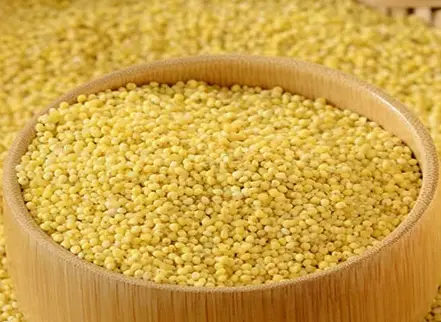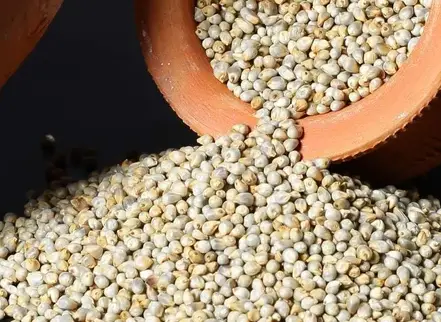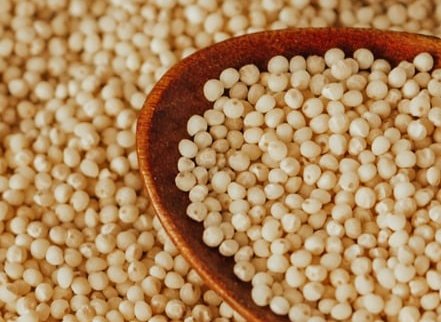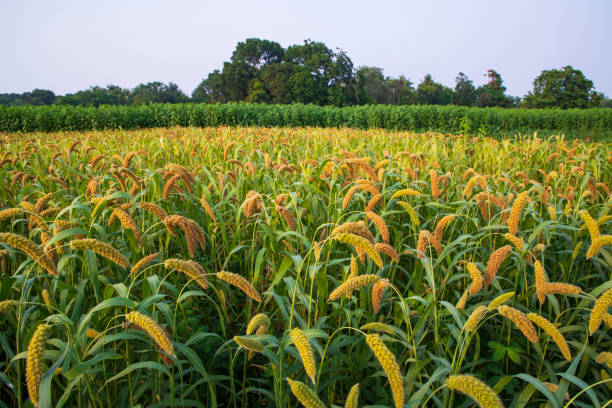Author: admin
-
![Red Corn-[சிவப்பு சோளம்]](https://amzfarm.com/wp-content/uploads/2025/02/25-red-maize-orgenic-of-seed-siddharth-fish-farm-original-imafvxsuyhfzccdf-1.webp)
Red Corn-[சிவப்பு சோளம்]
Benefits of Red Corn:
Red Corn is a highly nutritious grain known for its rich antioxidant content and numerous health benefits. It is packed with anthocyanins, which are powerful antioxidants that help reduce oxidative stress and protect the body from inflammation and chronic diseases. These antioxidants also contribute to heart health by improving circulation and lowering the risk of heart disease. Red corn is a good source of fiber, which promotes healthy digestion, prevents constipation, and helps maintain a healthy weight. The grain also contains essential vitamins and minerals like iron, magnesium, and phosphorus, supporting overall health, energy production, and bone strength.
Red Corn offers several health benefits due to its rich nutrient profile. Here are some key benefits:
Rich in Antioxidants
- Red corn contains high levels of anthocyanins, which are powerful antioxidants that help combat oxidative stress, reduce inflammation, and protect the body from chronic diseases like heart disease and cancer.
Supports Heart Health
- The antioxidants in red corn help improve circulation and lower the risk of heart disease by reducing oxidative damage. Additionally, the fiber content helps lower cholesterol levels, contributing to better cardiovascular health.
Aids Digestion
- Red corn is a good source of fiber, which promotes digestive health, prevents constipation, and ensures regular bowel movements. Fiber also supports a healthy gut microbiome.
Regulates Blood Sugar
- Red corn has a low glycemic index, which means it helps maintain stable blood sugar levels and is a suitable option for individuals with diabetes.
Boosts Metabolism
- The B-vitamins in red corn, especially B1 (Thiamine), help enhance metabolism, ensuring that the body efficiently converts food into energy.
Nutritional Content of Red Corn (Per 100g, Raw):
- Calories: ~365 kcal
- Carbohydrates: ~74 g
- Protein: ~9 g
- Fat: ~4 g
- Fiber: ~7 g
- Iron: ~2.3 mg
- Magnesium: ~200 mg
- Phosphorus: ~280 mg
- Antioxidants: High (due to ahocyanin content)
Features of Red Corn:
Feature Details Color Red (due to anthocyanin content) Antioxidants High in anthocyanins, which help fight oxidative stress and inflammation. Fiber Content Rich in dietary fiber, aids in digestion and weight management. Carbohydrates Contains complex carbohydrates that provide sustained energy. Protein Provides 9g of protein per 100g, supporting muscle repair and growth. Fat Content Contains healthy fats, though in moderate amounts. Vitamins Rich in B-vitamins like B1 (thiamine) and B3 (niacin) for energy production. Minerals Good source of iron, magnesium, and phosphorus, supporting bone health, energy production, and immune function. Glycemic Index Low glycemic index, ideal for regulating blood sugar levels. Digestive Health High in fiber, supporting healthy digestion and reducing constipation. Heart Health Antioxidants and fiber help reduce cholesterol levels and support cardiovascular health. Bone Health Contains magnesium and phosphorus, essential for strong bones and teeth. Skin Health Antioxidants help protect the skin from oxidative damage, promoting healthy skin. Weight Management Due to its fiber content, helps with satiety and controlling hunger. Uses Can be used in various dishes like porridge, snacks, and flour for baking -

Foxtail Millet Rice/ஃபாக்ஸ்டெயில் தினை அரிசி
Foxtail Millet Rice – Benefits, Nutrition & Uses
Foxtail Millet Rice, also known as Thinai Rice in Tamil, is a highly nutritious, gluten-free ancient grain that is packed with fiber, protein, iron, and essential minerals. As a staple in many Asian and African countries, it is widely consumed for its numerous health benefits.
Nutritional Profile of Foxtail Millet Rice (Per 100g)
- Calories – ~351 kcal
- Carbohydrates – 60-65g
- Protein – 12gFiber – 6-8g
- Fat – 4g
- Calcium – 31mg
- Iron – 2.8mg
- Magnesium – 81mg
- Phosphorus – 290mg
Health Benefits of Foxtail Millet Rice
1. Helps in Weight Loss
- High fiber content keeps you full for a long time, reducing cravings.
- Low in fat and rich in complex carbohydrates that boost metabolism.
- Prevents overeating and helps in fat reduction.
2. Regulates Blood Sugar Levels – Diabetes-Friendly
- Low Glycemic Index (GI) prevents rapid sugar spikes.
- Rich in slow-digesting carbohydrates, making it ideal for diabetics.
- Helps in insulin regulation and prevents diabetes-related complications.
3. Improves Digestion & Prevents Constipation
- Rich in dietary fiber, which promotes a healthy gut.
- Prevents constipation, bloating, and acidity.
4. Good for Heart Health – Lowers Cholesterol
- Contains essential fatty acids that reduce bad cholesterol (LDL).
- Helps prevent blockages in arteries, reducing heart disease risk.
- Rich in antioxidants, which protect against oxidative stress.
5. Strengthens Bones & Improves Joint Health
- Rich in calcium and phosphorus, which are essential for strong bones.
- Supports bone development in children and pregnant women.
6. Boosts Immunity & Fights Diseases
- High in antioxidants, which help fight free radicals and strengthen immunity.
- Helps in reducing inflammation and prevents infections.
7. Improves Brain Function & Mental Health
- Rich in B vitamins, which enhance memory and cognitive function.
- Helps in reducing stress, anxiety, and depression.
- Promotes better sleep and brain development in children.
8. Increases Energy & Stamina
- A great source of slow-releasing carbohydrates, keeping you energetic.
- Ideal for athletes, fitness enthusiasts, and people with an active lifestyle.
9. Naturally Gluten-Free – Safe for Celiac Patients
- A great alternative to wheat-based grains for those with gluten intolerance.
- Helps in reducing digestive disorders related to gluten sensitivity.
Foxtail Millet Rice vs. White Rice – Which is Better?
Feature Foxtail Millet Rice White Rice Fiber High (6-8g) Low (0.6g) Protein 12g 6-7g Calcium 31mg Negligible Iron 2.8mg 0.2mg Glycemic Index Low (Diabetic-Friendly) High (Blood Sugar Spike) Gluten-Free Yes Yes Weight Loss Yes No
-

Country Pearl Millet/நாட்டுக்கம்பு
Country Pearl Millet – Benefits, Nutrition & Uses
Country Pearl Millet, also known as Bajra in India, is one of the most nutritious and ancient grains cultivated for thousands of years. It is a gluten-free, high-fiber, and protein-rich grain that offers numerous health benefits, including improved digestion, diabetes control, heart health, and weight management.
Nutritional Profile of Country Pearl Millet (Per 100g)
- Calories – ~361 kcal
- Carbohydrates – 67g
- Protein – 12g
- Fiber – 8g
- Fat – 5g
- Calcium – 42mg
- Iron – 8mg
- Magnesium – 137mg
- Phosphorus – 296mg
- Potassium – 242mg
Health Benefits of Country Pearl Millet
1. Aids in Weight Loss & Improves Metabolism
- Rich in dietary fiber, which keeps you full for longer and reduces hunger pangs.
- Boosts metabolism, helping in effective calorie burning.
- Helps prevent overeating and cravings, supporting weight management.
2. Helps Regulate Blood Sugar Levels – Diabetes-Friendly
- Low Glycemic Index (GI) prevents sudden spikes in blood sugar.
- Rich in complex carbohydrates, ensuring slow digestion and steady glucose release.
- Helps improve insulin sensitivity, reducing diabetes complications.
3. Supports Digestive Health
- High fiber content promotes healthy digestion and prevents constipation.
- Acts as a natural detoxifier, cleansing the intestines and reducing bloating.
- Supports gut-friendly bacteria, improving overall gut health.
4. Strengthens Bones & Prevents Osteoporosis
- Rich in calcium, phosphorus, and magnesium, which are crucial for bone strength.
- Helps in reducing joint pain and bone loss, especially in older adults.
- Supports bone development in children and pregnant women.
5. Boosts Heart Health & Reduces Cholesterol
- Contains heart-friendly nutrients like potassium and magnesium.
- Helps reduce bad cholesterol (LDL) and promotes good heart function.
- Improves blood circulation and lowers blood pressure.
6. Enhances Immunity & Fights Infections
- Packed with antioxidants, which help fight free radicals.
- Rich in iron and zinc, essential for immune function and preventing anemia.
- Helps the body recover from fatigue, infections, and inflammation.
7. Improves Brain Function & Reduces Stress
- Contains B vitamins, which support better memory and brain function.
- Helps reduce stress, anxiety, and mental fatigue.
- Supports cognitive health in children, students, and the elderly.
8. Provides Long-Lasting Energy – Great for Fitness Enthusiasts
- Slow-releasing carbohydrates ensure sustained energy levels.
- Ideal for athletes, gym-goers, and active individuals.
- Helps in muscle recovery and stamina building.
9. Naturally Gluten-Free – Ideal for Celiac Patients
- Safe for people with gluten allergies and wheat intolerance.
- A great alternative to wheat-based products like rotis, dosas, and porridge.
Country Pearl Millet vs. White Rice – Which is Healthier?
Feature Country Pearl Millet White Rice Fiber High (8g) Low (0.6g) Protein 12g 6-7g Calcium 42mg Negligible Iron 8mg 0.2mg Glycemic Index Low (Diabetic-Friendly) High (Blood Sugar Spike) Gluten-Free Yes Yes Weight Loss Yes No Clearly, Pearl Millet is a superior choice as it is higher in fiber, protein, and minerals while also being diabetes-friendly.
-

White urid Dal/வெள்ளை உருட்டு உளுந்து
White Urad Dal – Benefits, Nutrition & Uses
White Urad Dal, also known as Split Black Gram (without skin), Ulundhu (Tamil), Minumulu (Telugu), and Mash Dal (Hindi), is a protein-rich, fiber-packed, and highly nutritious pulse widely used in Indian cuisine. It is an excellent source of plant-based protein, iron, calcium, and essential minerals, making it beneficial for people of all ages.
Nutritional Profile of White Urad Dal (Per 100g)
Calories – 347 kcal
Carbohydrates – 59g
Protein – 25g
Fiber – 18g
Fat – 1.4g
Calcium – 138mg
Iron – 7.57mg
Magnesium – 267mg
Phosphorus – 379mg
Potassium – 983mg
Health Benefits of White Urad Dal
1. Rich in Protein – Supports Muscle Growth & Repair
- High plant-based protein content, essential for muscle building and recovery.
- Helps improve stamina and endurance, making it great for athletes and fitness enthusiasts.
- Ideal protein source for vegetarians and vegans.
2. Aids Digestion & Promotes Gut Health
- High fiber content prevents constipation and supports a healthy gut.
- Acts as a natural detoxifier, flushing out toxins from the digestive system.
- Contains prebiotics, which promote the growth of good gut bacteria.
3. Regulates Blood Sugar – Diabetes-Friendly
- Low Glycemic Index (GI) prevents blood sugar spikes.
- Rich in fiber and complex carbs, ensuring slow and steady glucose release.
- Helps improve insulin sensitivity, making it ideal for diabetics.
4. Strengthens Bones & Prevents Osteoporosis
- High calcium, magnesium, and phosphorus content supports bone health.
- Ideal for pregnant women and growing children to strengthen bones.
5. Improves Heart Health & Lowers Cholesterol
- Contains heart-friendly nutrients like potassium and magnesium.
- Lowers bad cholesterol (LDL) and promotes cardiovascular function.
- Helps regulate blood pressure and improve blood circulation.
6. Boosts Energy & Reduces Fatigue
- Rich in iron, which boosts hemoglobin levels and prevents anemia.
- Helps increase energy levels and reduce weakness and fatigue.
- Beneficial for pregnant women, menstruating women, and growing children.
7. Enhances Brain Function & Reduces Stress
- Rich in B-complex vitamins, which improve cognitive function and memory.
- Helps reduce stress, anxiety, and mental fatigue.
- Supports better concentration and focus for students and working professionals.
8. Supports Weight Management
- High fiber keeps you full longer, reducing unnecessary cravings.
- Low in fat and high in protein, making it an ideal food for weight loss.
- Helps regulate metabolism and prevents overeating.
9. Improves Skin & Hair Health
- Packed with antioxidants, which fight free radicals and delay aging.
- Rich in iron and essential minerals, promoting hair growth and reducing hair fall.
- Helps keep skin glowing and hydrated.
White Urad Dal vs. Black Urad Dal – What’s the Difference?
Feature White Urad Dal (Split & Skinned) Black Urad Dal (Whole with Skin) Protein High (25g per 100g) Slightly higher (26g per 100g) Fiber Moderate (18g per 100g) Higher (22g per 100g) Iron High (7.57mg) Higher (8.5mg) Digestibility Easier to digest Takes longer to digest Common Uses Idli, dosa, vada, dal curries Dal Makhani, soups, khichdi Both varieties offer exceptional health benefits, but white urad dal is easier to digest and commonly used for fermented foods like idli and dosa.
-

Proso Millet/பனி வரகு
Proso Millet – Benefits, Nutrition & Uses
Proso Millet, also known as Chena (Hindi), Panivaragu (Tamil), Variga (Telugu), and Barri (Bengali), is an ancient gluten-free grain loaded with protein, fiber, essential vitamins, and minerals. It is widely cultivated due to its high nutritional value, quick-growing nature, and ability to thrive in dry conditions. This millet is gaining popularity as a healthy alternative to rice and wheat, offering benefits such as weight loss, improved digestion, diabetes control, and enhanced heart health.
Nutritional Profile of Proso Millet (Per 100g)
Calories – 354 kcal
Carbohydrates – 70g
Protein – 12.5g
Fiber – 8.5g
Fat – 1.5g
Calcium – 14mg
Iron – 2.9mg
Magnesium – 106mg
Phosphorus – 285mg
Potassium – 195mg
Vitamin B6 – 0.47mg
Health Benefits of Proso Millet
1. Aids in Weight Loss & Improves Metabolism
- High in dietary fiber, which promotes satiety and reduces frequent snacking.
- Boosts metabolism, helping in effective fat burning.
2. Controls Blood Sugar Levels – Diabetes-Friendly
- Low Glycemic Index (GI), preventing sudden blood sugar spikes.
- Rich in slow-digesting carbohydrates, ensuring steady glucose release.
- Helps regulate insulin levels, making it ideal for diabetics.
3. Enhances Digestive Health & Prevents Constipation
- Rich in fiber, which supports a healthy gut and prevents bloating.
- Aids in detoxifying the digestive system, keeping intestines clean.
- Promotes the growth of good gut bacteria, improving digestion.
4. Strengthens Bones & Prevents Osteoporosis
- Contains calcium, magnesium, and phosphorus, crucial for bone health.
- Helps in bone strengthening and reducing joint pain, especially in elders.
- Supports proper bone development in children and pregnant women.
5. Improves Heart Health & Lowers Cholesterol
- Rich in antioxidants, which help reduce oxidative stress on the heart.
- Lowers bad cholesterol (LDL) and promotes good cholesterol (HDL).
- Supports healthy blood circulation and reduces high blood pressure.
6. Boosts Immunity & Fights Infections
- Packed with antioxidants, iron, and zinc, which strengthen immunity.
- Helps the body fight fatigue, infections, and inflammation.
- Improves red blood cell production, preventing anemia.
7. Enhances Brain Function & Reduces Stress
- Rich in B-complex vitamins, which support memory and cognitive function.
- Helps in reducing stress, anxiety, and mental fatigue.
- Supports brain health in students, working professionals, and elders.
8. Provides Long-Lasting Energy – Ideal for Athletes
- Slow-digesting carbs ensure steady energy release throughout the day.
- Excellent food for athletes, gym-goers, and people with active lifestyles.
- Helps in muscle recovery and stamina building.
9. Naturally Gluten-Free – Safe for Celiac Patients
- 100% gluten-free, making it safe for people with gluten allergies and celiac disease.
- A healthy substitute for wheat and refined grains in daily meals.
Proso Millet vs. White Rice – Which is Healthier?
Feature Proso Millet White Rice Fiber High (8.5g) Low (0.6g) Protein 12.5g 6-7g Calcium 14mg Negligible Iron 2.9mg 0.2mg Glycemic Index Low (Diabetic-Friendly) High (Blood Sugar Spike) Gluten-Free Yes Yes Weight Loss Yes No Clearly, Proso Millet is a superior option due to its higher fiber, protein, and mineral content while also being diabetes-friendly.
-

White Corn/வெள்ளை சோளம்
White Corn – Benefits, Nutrition & Uses
White Corn, also known as Maize, is a nutritious grain packed with fiber, antioxidants, and essential vitamins. It is a naturally gluten-free cereal, making it an excellent alternative for people with gluten intolerance. White Corn is widely consumed as a staple food in many countries and is used in a variety of dishes, from tortillas and popcorn to porridge and soups.
Nutritional Profile of White Corn (Per 100g)
Calories – ~365 kcal
Carbohydrates – 74g
Protein – 9.4g
Fiber – 7g
Fat – 4.7g
Vitamin A – 90 IU
Vitamin C – 0.2mg
Calcium – 2mg
Iron 2.7mg
Magnesium – 127mg
Phosphorus – 210mg
Health Benefits of White Corn
1. Supports Digestive Health
- High fiber content promotes digestion and prevents constipation.
- Acts as a prebiotic, supporting the growth of beneficial gut bacteria.
- Helps in detoxifying the body naturally.
2. Aids in Weight Management
- Low in fat and high in fiber, keeping you full longer and preventing overeating.
- Provides sustained energy, making it a great food for weight watchers and fitness enthusiasts.
3. Good for Diabetics – Helps Regulate Blood Sugar
- Low Glycemic Index (GI) prevents sudden spikes in blood sugar levels.
- High in complex carbohydrates, ensuring slow digestion and steady glucose release.
4. Boosts Heart Health
- Contains antioxidants like lutein and zeaxanthin, which reduce the risk of heart disease.
- Rich in magnesium and potassium, which help regulate blood pressure.
- Helps lower bad cholesterol (LDL) and improves overall heart function.
5. Enhances Eye Health
- Rich in Vitamin A and antioxidants, which protect the eyes from age-related damage.
- Lutein and zeaxanthin in White Corn help prevent cataracts and macular degeneration.
6. Strengthens Bones & Prevents Osteoporosis
- Contains magnesium and phosphorus, essential for bone strength.
- Helps in calcium absorption, making bones stronger and reducing joint pain.
7. Supports Immune Function
- Rich in essential vitamins and minerals, boosting immunity.
- The presence of antioxidants helps fight infections and improves overall well-being.
8. Improves Brain Function & Reduces Stress
- Contains B vitamins like Niacin and Thiamine, which enhance brain health.
- Helps in reducing stress and fatigue, improving cognitive function.
9. Naturally Gluten-Free – Ideal for Gluten Sensitivity
- Safe for people with Celiac Disease and those allergic to wheat.
- Can be used in a variety of gluten-free recipes, such as corn tortillas and porridge.
White Corn vs Yellow Corn – Which is Better?
Feature White Corn Yellow Corn Color White Yellow Taste Slightly Sweet Sweeter Fiber High (7g) High (7g) Antioxidants Lutein & Zeaxanthin More Carotenoids Calories 365 kcal 365 kcal Gluten-Free Yes Yes Heart Health Yes Yes Weight Loss Yes Yes
-
![Ragi-[ராகி]](https://amzfarm.com/wp-content/uploads/2025/02/image-11-1.jpg)
Ragi-[ராகி]
Ragi (Finger Millet) – Benefits, Nutrition & Uses
Ragi, also known as Finger Millet, is a super grain packed with protein, fiber, calcium, and essential nutrients. It is a staple in South Indian diets and is known for its weight loss, diabetes management, and bone-strengthening properties. Ragi is a gluten-free grain and an excellent substitute for wheat and rice, making it ideal for people with gluten intolerance.
Nutritional Profile of Ragi (Per 100g)
- Calories – ~336 kcal
- Carbohydrates – 72g
- Protein – 7-8g
- Fiber – 11-15g
- Fat – 1.3g
- Calcium – 344mg (highest among grains)
- Iron – 3.9mg
- Magnesium – 137mg
- Phosphorus – 283mg
Health Benefits of Ragi
1. Rich in Calcium – Strengthens Bones & Teeth
- Highest natural source of calcium among cereals (~344mg per 100g).
- Essential for bone growth in children and prevents osteoporosis in adults.
- Ideal for pregnant women, elderly people, and athletes to maintain bone health.
2. Aids in Weight Loss & Boosts Metabolism
- High fiber content keeps you full longer and reduces hunger cravings.
- Helps regulate appetite and metabolism, aiding in healthy weight loss.
- Low in fat and rich in complex carbohydrates that provide sustained energy.
3. Diabetes-Friendly – Regulates Blood Sugar
- Low Glycemic Index (GI) prevents sudden spikes in blood sugar levels.
- High fiber and polyphenols slow down glucose absorption.
- Recommended for diabetics and people with insulin resistance.
4. Improves Digestion & Prevents Constipation
- Rich in dietary fiber, which improves gut health.
- Prevents constipation, bloating, and acidity.
- Acts as a natural detoxifier, helping in removing toxins from the body.
5. Gluten-Free – Ideal for People with Gluten Intolerance
- Safe for people with Celiac Disease and those allergic to wheat.
- Can be used as a substitute for wheat flour in rotis, dosas, and baked goods.
6. High in Iron – Prevents Anemia
- Excellent plant-based source of iron, preventing anemia and fatigue.
- Especially beneficial for women, children, and elderly people.
- Enhances hemoglobin levels and supports red blood cell production.
7. Boosts Brain Function & Reduces Stress
- Contains Tryptophan, an amino acid that promotes serotonin production.
- Helps in reducing stress, anxiety, and depression.
- Improves cognitive function, memory, and mental clarity.
8. Good for Heart Health – Lowers Cholesterol & Blood Pressure
- Rich in antioxidants, reducing the risk of heart disease.
- Helps lower bad cholesterol (LDL) and maintains good cholesterol (HDL).
- Contains magnesium and potassium, which regulate blood pressure.
9. Enhances Immunity & Skin Health
- Packed with antioxidants, vitamins, and minerals that boost immunity.
- Helps in delaying aging and promotes healthy, glowing skin.
- The presence of methionine and lysine improves hair growth and skin elasticity.
Ragi vs. Wheat & Rice – Which is Better?
Feature Ragi (Finger Millet) Wheat Rice Fiber High (11-15g) Medium (5-7g) Low (0.6g) Calcium Very High (344mg) Low (30mg) Negligible Protein Good (7-8g) High (12-14g) Moderate (5-6g) Glycemic Index Low (Diabetic-Friendly) Medium High (Blood Sugar Spike) Gluten-Free Yes No Yes Weight Loss Yes, promotes satiety No No
-
![Pearl Millet Rice-[கம்பு அரிசி]](https://amzfarm.com/wp-content/uploads/2025/02/perl5_600x.jpg)
Pearl Millet Rice-[கம்பு அரிசி]
Benefits of Pearl Millet Rice :
Pearl Millet Rice (Kambu Arisi) is a highly nutritious grain that offers numerous health benefits. It is rich in essential nutrients like fiber, iron, magnesium, calcium, and phosphorus, all of which support overall health. The high fiber content in Pearl millet rice aids in improving digestion, preventing constipation, and enhancing gut health. It is an excellent source of sustained energy, making it ideal for active individuals, thanks to its complex carbohydrates. Additionally, its antioxidant properties help in fighting oxidative stress and reducing inflammation, which promotes heart health and supports a strong immune system. Pearl millet rice is also known for its ability to regulate blood sugar levels due to its low glycemic index, making it beneficial for people with diabetes
Pearl Millet Rice (Kambu Arisi) offers numerous health benefits, making it a nutritious choice for a balanced diet. Here are some of the key benefits:
Rich in Nutrients
- Pearl millet rice is packed with essential nutrients like fiber, iron, magnesium, phosphorus, and calcium. These nutrients help maintain overall health and support bodily functions.
Improves Digestion
- Kambu Arisi is rich in fiber, which promotes digestive health, prevents constipation, and enhances gut function. It helps regulate bowel movements and supports the healthy functioning of the digestive system.
Boosts Energy
- Being rich in complex carbohydrates, Pearl millet rice provides a sustained release of energy, making it ideal for active individuals and those looking for long-lasting energy throughout the day.
Supports Heart Health
- The fiber and antioxidants in Pearl millet help lower cholesterol levels, reduce inflammation, and improve blood circulation, all of which contribute to better heart health.
Aids in Weight Management
- Due to its high fiber content, Pearl millet rice helps you feel fuller for longer, reducing hunger and preventing overeating. This makes it beneficial for those looking to manage their weight effectively.
Regulates Blood Sugar
- Pearl millet has a low glycemic index, making it a great choice for diabetics. It helps in maintaining stable blood sugar levels and reduces the risk of blood sugar spikes.

nutritional values per 100 grams of raw pearl millet rice:
Nutrient Amount (per 100g) Energy 378 kcal Carbohydrates 72.85 g Protein 11.02 g Fat 4.22 g Fiber 8.5 g Calcium 42 mg Iron 8.5 mg Magnesium 114 mg Phosphorus 282 mg Potassium 280 mg Zinc 2.3 mg Folate (Vitamin B9) 85 µg Vitamin B1 (Thiamine) 0.31 mg Vitamin B2 (Riboflavin) 0.11 mg Vitamin B3 (Niacin) 1.3 mg Vitamin E 0.85 mg Key Nutritional Highlights:
- High in Carbohydrates: Provides complex carbohydrates that offer sustained energy.
- Rich in Protein: Contains a significant amount of plant-based protein (11g), making it a good source for vegetarians.
- High in Fiber: The fiber content (8.5g) helps with digestion, regulates bowel movements, and promotes gut health.
- Rich in Minerals: High levels of iron, magnesium, phosphorus, and calcium support bone health, red blood cell production, and overall bodily functions.
- Vitamins: It provides B-vitamins such as B1, B2, B3, and folate, which help in energy production, metabolic health, and nerve function.
-
![Little Millet Rice-[சாமை அரிசி]](https://amzfarm.com/wp-content/uploads/2025/02/kutki-millet-simply-earth_medium_0697137-2.webp)
Little Millet Rice-[சாமை அரிசி]
Little Millet Rice (Samai) – Benefits, Nutrition & Uses
Little Millet, also known as Samai (Tamil), Kutki (Hindi), Sama (Telugu), and Saame (Kannada), is a highly nutritious and gluten-free grain that has been consumed in India for centuries. It is a great alternative to white rice and is rich in fiber, protein, vitamins, and essential minerals.
Nutritional Profile of Little Millet (Per 100g)
Calories – ~329
kcalCarbohydrates – 67g
Protein – 7-9
gFiber – 7-9g
Fat – 4.5g
Calcium – 17mgIron – 9.3mg
Magnesium – 55mgZinc – 2.3mg
Health Benefits of Little Millet Rice (Samai)
1. Diabetes-Friendly & Regulates Blood Sugar
- Low Glycemic Index (GI) prevents sudden spikes in blood sugar levels.
- Rich in fiber, which slows glucose absorption and improves insulin sensitivity.
- A great rice substitute for people with diabetes and prediabetes.
2. Aids in Weight Loss & Boosts Metabolism
- High fiber content keeps you full longer, reducing frequent hunger pangs.
- Low in calories and high in complex carbohydrates, promoting slow digestion.
- Boosts metabolism and fat burning, aiding in healthy weight management.
3. Improves Digestion & Gut Health
- Rich in dietary fiber, which prevents constipation and promotes smooth digestion.
- Supports gut-friendly bacteria, improving overall digestive health.
- Helps detoxify the body naturally.
4. Heart-Healthy & Reduces Cholesterol
- Rich in antioxidants & fiber, helping lower bad cholesterol (LDL).
- Contains magnesium and potassium, which regulate blood pressure.
- Reduces the risk of heart disease and stroke.
5. Strengthens Bones & Prevents Osteoporosis
- Good source of calcium, phosphorus, and magnesium, essential for bone strength.
- Helps prevent osteoporosis and joint-related issues, making it ideal for women and elderly people.
6. Enhances Immunity & Prevents Deficiencies
- Rich in iron and zinc, boosting immunity and preventing anemia.
- Helps improve hemoglobin levels and oxygen transport in the body.
- Essential for growing children, pregnant women, and people recovering from illness.
7. Gluten-Free & Suitable for Gluten Sensitivity
- Ideal for people with gluten intolerance (Celiac Disease) and wheat allergies.
- Helps in reducing bloating, inflammation, and digestive discomfort.
8. Rich in Antioxidants & Protects Against Diseases
- Contains polyphenols and flavonoids, which fight free radicals and prevent cell damage.
- Reduces inflammation and protects against cancer, aging, and chronic diseases.
Little Millet Rice vs White Rice – Which is Better?
Feature Little Millet Rice White Rice Fiber High (7-9g) Low (0.6g) Protein More (7-9g) Less (5-6g) Glycemic Index Low (Diabetic-Friendly) High (Spikes Blood Sugar) Calcium & Iron High Low Digestion Easy & Light Easy but Low Fiber Weight Loss Yes, promotes satiety No, leads to quick hunger Heart Health Reduces cholesterol No benefits

